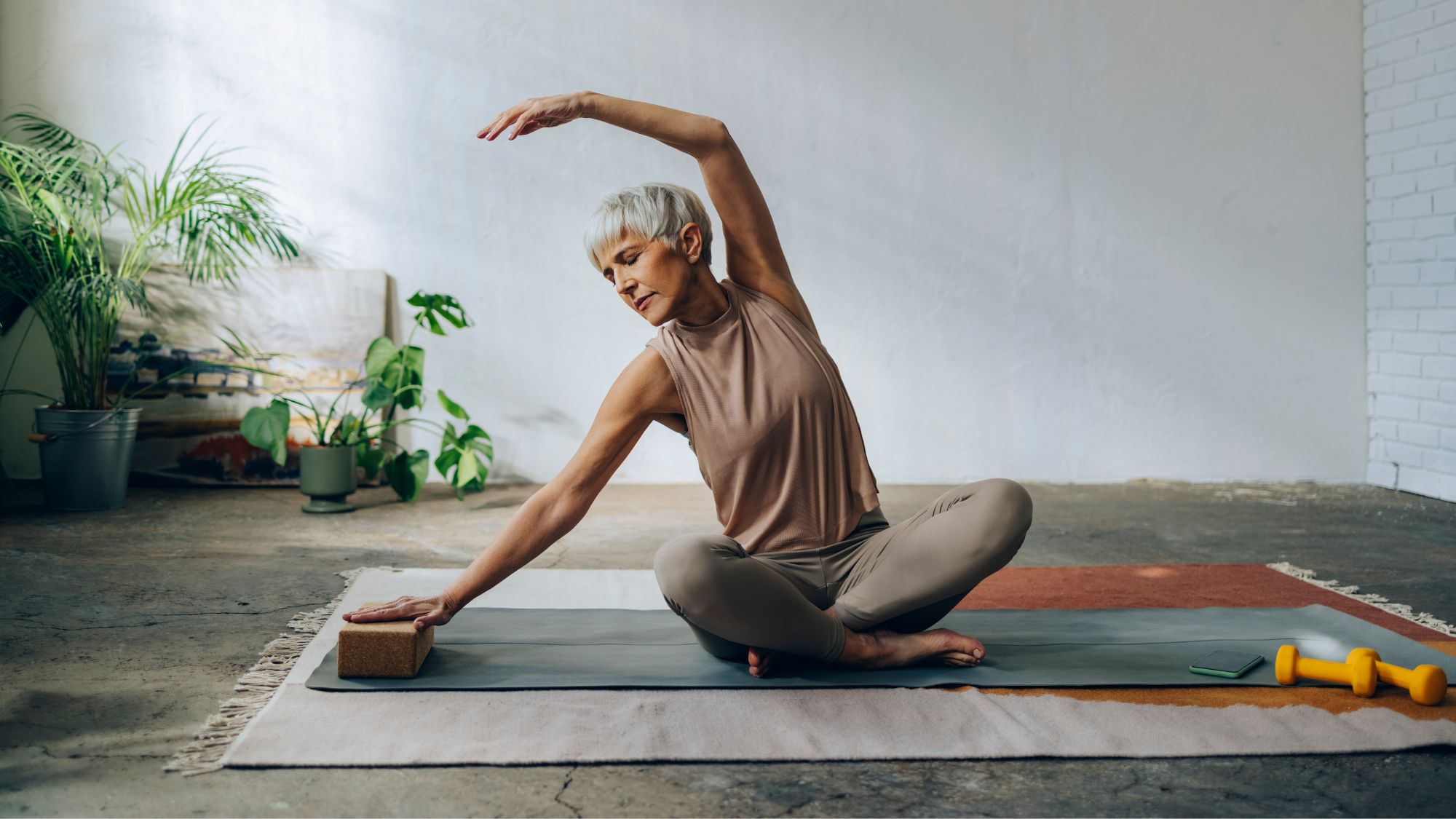This is your failsafe guide to how to stay fit in your 60s, according to top pros
Top tips from experts in the know.


By the time you reach your 60s, there are myriad reasons you may be less active than you were twenty or thirty years ago. Bodies and circumstances evolve over time, as do the types of movement we enjoy – team that with the fact that most generalised exercise advice tends to be targeted at people decades your junior, it can be hard to know how to stay fit in your 60s. Where to even start?
Stats from Sport England suggest that 42% of people aged 55 and over are inactive, compared to 29% of the population. Elsewhere, research by the NHS in 2021 revealed that only 14% of women aged 65 and over met both the muscle-strengthening and balance exercise guidelines for their age group. Meanwhile, a 2019 study published in the International Journal of Environmental Research and Public Health confirmed an association between meeting physical activity recommendations and functional fitness and quality of life in women over the age of 60. In short, keeping moving is crucial.
“Staying active in your 60s is important because as we age our bodies naturally undergo changes that can challenge our mobility, strength, and overall health,” explains Joanna Meyer, personal trainer at Nordic Balance. “Remaining active helps counter these effects by improving cardiovascular health, maintaining muscle mass, and enhancing flexibility and balance. This can significantly reduce the risk of chronic diseases such as arthritis, heart disease, and osteoporosis while also aiding in better mental health outcomes and increased longevity.”
If you’re unsure how to stay fit in your 60s, we asked Meyer, along with Nancy Best, personal trainer and founder of Ladies Who Crunch for their best bits of advice.
How to stay fit in your 60s
What is the best exercise for 60 year olds?
“After the age of 50, bone density starts to decline, meaning our bodies lose bone faster than we can rebuild it,” says Best. As we age, our chances of developing osteoporosis increase, making bones fragile and more at risk of breaking. “Hormonal changes accelerate this process too; women can lose up to 20% of their bone density within 5 to 7 years following menopause,” Best adds. “This means it’s vital to continue strength training, as we age. It helps to build muscle mass, amongst many other benefits.” A 2021 study supports Best’s recommendation. It found that resistance training three times a week for 15 weeks improved health-related quality of life in postmenopausal women.
Aerobic exercise is also incredibly important for heart health, as we age. Improving your cardiovascular fitness improves your capacity to pump blood around your body. It may be advisable to avoid – or do less – high-intensity cardio, however. “We know our bodies are more susceptible to injuries and breakages as we age, so a low-impact approach to cardio is preferable unless you’re someone who has trained consistently throughout your life,” Best says.
In addition to strength training and cardio, maintaining your functional mobility is helpful to protect spinal health and reduce joint stiffness, Best says, while simply getting your steps in each day has the potential to improve your overall health tenfold. “We know from multiple pieces of research that maintaining a consistent step count can help improve health markers,” says Best. “For example, research published in August last year found that a 1,000-step increment was associated with a 15% decreased risk of all-cause mortality. As long as you’re incrementally increasing your totals, you’re going to reap the benefits (it doesn’t have to be the much-debated 10k steps a day!)”
Celebrity news, beauty, fashion advice, and fascinating features, delivered straight to your inbox!
That said, there’s no one-size-fits-all approach to keeping fit in your 60s – the goal, according to Best, is to find the balance between what you enjoy and what your body needs to stay strong and healthy.
Should a 60 year old lift heavy weights?
Weight training, we’ve already established, is important for promoting good health in your 60s, but should you be lifting heavy weights?
It depends on your level of experience with weight lifting, Best says. “No one should be lifting heavy weights as a beginner. You need to master the technique and apply controlled progressive overload, which requires time and practice.”
If you have been lifting weights consistently for many years, without any injuries, then Best gives the green light to lifting heavy in your 60s under the supervision or guidance of a qualified professional. Strength training for beginners - go, go, go.
How many times a week should a 60 year old lift weights?
For adults aged 65 and above, the NHS recommends at least 150 minutes of moderate intensity activity – or 75 minutes of vigorous intensity activity, if you’re already active – a week (or a combination of both). It also advises doing activities that improve strength, balance and flexibility at least two times per week.
Meyer agrees with this recommendation. “Lifting weights two to three times per week is ideal for maintaining muscle strength and bone density,” she says. “Cardiovascular activities like walking, swimming, or cycling can be done on most days of the week, depending on one's overall health and fitness levels.”
How to stay fit in your 60s – 8 tips from personal trainers
1. Prioritise your protein intake
“Protein makes up about 50% of the volume of bone in our bodies and about 33% of its mass,” explains Best. “Eating enough high-quality protein contributes to maintenance of sufficient muscle mass and function, which is critical for overall bone health and helps reduce the risk of osteoporosis for women as they age.”
Foods high in protein include meat, fish and eggs, plus plant-based sources such as nuts, seeds and tofu. Our guides to the best protein powders and how much protein you need to eat to build muscle will also come in handy here. Plant-based? There are plenty of vegan protein options, too.
2. Experiment with different type of activity
Meyer recommends trying out a few different types of low-impact exercise to find out what you enjoy, and which movement types best fit your lifestyle and circumstances. “Activities like yoga or Tai Chi can improve flexibility, reduce stress, and enhance balance, which is vital for preventing falls,” she says.
You may also like to try Pilates workouts, walking, cycling or swimming – all of which are gentle-on-the-joints activities you can take at your own pace.
3. Dedicate 10 minutes a day to mobility training
Improving your flexibility and range of motion, according to Best, is going to help you avoid injury and ensure you can continue to move pain free.
Apps such as Fiit offer mobility exercise session, and YouTube is a great resource too. However, in-person coaching is advised to ensure you move in a way that's beneficial to your body and doesn't risk injury. Check out your local yoga and Pilates studios and enquire about 1-1 coaching for mobility and flexibility.
4. Participate in group activities
Signing up to a yoga class, taking tennis lessons or joining a local walking club all bring a social element to exercise. This, Meyer says, can help to boost motivation and make physical activity fun.
Explore what's on offer at your local gym or leisure centre, and use Facebook to search for activity groups in your area.
5. Lifts weights at least twice a week
Per the NHS guidelines and Best's advice, she recommends lifting weights at least twice a week, whether in a fitness facility or at home. “The British Journal of Sports Medicine published findings that showed that muscle strengthening was associated with a 10% to 17% lower risk of death,” says Best.
If you're new to weight lifting, it's advisable to seek support from a personal trainer who can coach proper form and devise a plan that suits your goals and circumstances.
6. Set reminders to move
If you’re someone who typically spends a lot of time sitting, Meyer recommends setting yourself reminders to regularly move your body. This can involve short walks around you home to make a cuppa, or doing a five-minute stretch sequence on your yoga mat.
Research indicates that even 10 minutes of movement has health benefits to offer, so it's worth working some exercise 'snacks' into your day to increase overall activity levels.
7. Stay hydrated
“As you age, you’ll experience a reduction in the sensation of thirst and renal function,” says Best. Research suggests that adults who stay well-hydrated are healthier and develop fewer chronic conditions than those who aren't sufficiently hydrated.
Best recommends aiming for six to eight glasses of water a day, starting from first thing in the morning.
8. Take rest days
No matter your age, says Best, make sure you’re building adequate recovery around your training. This is when your body repairs and rebuilds post-workout, and when you’re able to replenish energy stores so you feel prepared to be active again the following day.
Rest doesn't need to mean a sofa day (although it absolutely can!) – you can also take active rest between training days, which could involve gentle activity such as walking, yoga, or cycling.
Shop MC UK approved workout kit now:

Abbi Henderson is a freelance journalist and social media editor who covers health, fitness, women’s sport and lifestyle for titles including Women's Health and Stylist, among others.
With a desire to help make healthcare, exercise and sport more accessible to women, she writes about everything from the realities of seeking medical support as a woman to those of being a female athlete fighting for equality.
When she’s not working, she’s drinking tea, going on seaside walks, lifting weights, watching football, and probably cooking something pasta-based.


